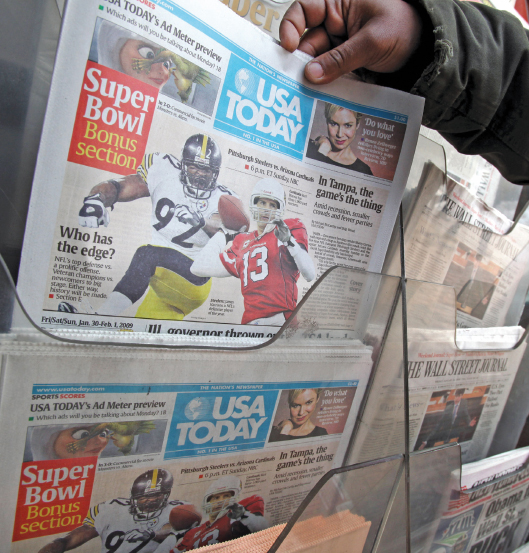Journalism in the Technology Age
Printed Page 74
In the early 1980s, two technology advances—an emphasis on color printing and digitization of news content—ushered in a new brand of journalism that looked and operated quite differently from earlier forms. USA Today, launched in 1982 and influenced by television, led the way in the use of color and brevity of content. And in 1980, the Columbus Dispatch became the first paper to go online.

USA Today Colors the Print Landscape
USA Today made its mark by emphasizing visual style over substantive news or analysis and using brief news items to appeal to busy readers with shortened attention spans. Now the most widely circulated paper in the nation, USA Today represents the only successful launch of a new major American daily newspaper in the last several decades. Demonstrating keen marketing savvy, USA Today uses TV-inspired color and design. The paper also employs a writing style that mimics TV news—casting many reports in the present tense rather than the past tense to create a sense of immediacy.
Online Journalism Redefines the News Process
Today, rather than subscribing to printed news-papers, many people start their day by logging on to the Internet and scanning a wide variety of free news sources, including print papers’ and cable news channels’ sites, newsmagazines’ sites, blogs, and news headlines aggregated by search engines such as Google. This development has reshaped the way the news process works.
Specifically, the advent of online journalism has radically speeded up the news cycle: In mere moments, stories about anything ranging from a politician’s scandalous affair to a rampaging chimp to the discovery of a possible cause of autism can be posted in every possible place on the Internet—complete with audio and video. And these accounts can be updated practically in real time. Printed newspapers, not wanting to be left behind, have felt compelled to cover the stories attracting the most interest online. This reactive behavior can sometimes create an avalanche effect, whereby a small story that appears first on the Internet cascades through cable, network news, and then newspapers. Such stories stay in the public eye perhaps far longer than they would have in pre-Internet days, and they can take on a magnitude that may be out of proportion with their real significance.